
Greetings all!
I've been hooked by the sourdough bug! After making a loaf of "OK" bread by following Alton Browns instructions I decided to give making my own sourdough starter a go. This didn't meet with great success at first. I seems that my starter (made from 1 cup KA Flour, 1 cup filtered water and 1 tablespoon honey) took longer than the instructions I have read suggested. Now after three weeks of daily feedings and two to three times a day stirrings my starter seems to have taken on a life of its own. I usually get a doubling in size 4 - 5 hours after feeding in the AM then the afternoon stir settles everything back down and another 4 - 5 hours later doubled again! One more stirring and it's time for bed... the next am before tossing 1/2 out and feeding again I notice that it appears to have risen and fallen about double a third time.
Is this normal?
The starter has a great sour smell. These days I give it 1/2 cup of rye flour once or twice a week which really seems to sour it up and has added a nice color and flavor to the bread.
Anyway, I have been mixing my dough by hand and then kneading for about 25 minutes, again by hand. the dough is a little sticky but not so much that it can't be handled or worked. I then put it in a salad spinner basket that has been lined with a cotton cloth and liberally sprinklered with flour to proof over night.
The next AM I find my dough to have about doubled in size (8 or 9 hours later) and then turn it out onto a preheated pizza stone in the oven for cooking. A quick slash or three with the razor and I struggle not to open the door to smell and see how it's doing. 45 minutes later... (see attached picture)




What I notice is that when I turn out my dough it seems to fall back in on itself. Though it does rise (spring?) in the oven a little I usually end up with a thick Frisbee shaped loaf. I think that the crumb is pretty good and it tastes great, but a little flat. I also don't seem to get much action from the slashes... at least not like I see in all these wonderful pictures.
What gets me is that Alton Brown's "OK" bread held its shape while proofing while just sitting on the counter, held its shape in the oven and exploded as it cooked to almost 3 times the size it started as! It wasn't near as good tasting or textured as the loafs I've been making, but still... the slashes were wide open and separated and it looked like everything my store deadened senses thought it should look like.
The last loaf didn't even brown much, but stayed a pretty white... but still they taste good! So I must be doing something right... My wife says that I've become obsessed but does enjoy the fruits of my labors.
Any suggestions you might have would be welcome!!


The results of my 9-11-10 attempt. I fed my starter this AM and it will be ready to go tonight... Any thoughts on what to try next? See my detailed post at the end of this threat.
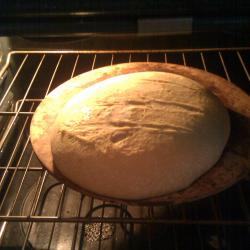
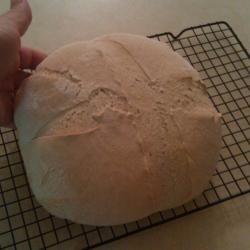
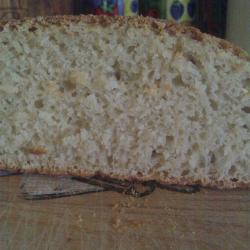
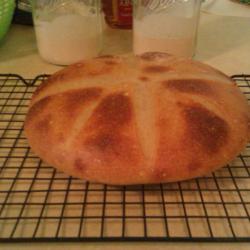
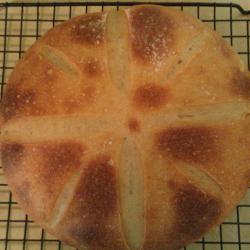
Replies
Hmm- sounds like you should be getting better results, but a couple of things cross my mind. Can you get any humidity in that oven? One trick I ran across the other day (in a commercial trade publication, to my surprise) is to soak a brick in water overnight and stick it in the oven with the bread! Might work.
The other thing I noticed is that you mention "flat" taste. Makes me wonder if you've cut the salt level back, which could account for weakness in the oven as well as the flat taste.
I'm on the road (Boardman, Washington, USA) 400 miles from home today and am having a little car trouble, so I don't know when I'll be able to follow up, but I hope this helps.
Good luck,
Muff
Actually what I meant to say is the though the bread is kinda flat in shape it does taste great. Lots of good flavor. I'm pretty pleased with my starter and how it seems to be working.
I haven't been putting water or any moisture in the oven and was reading about that last night. I'll try it this weekend. I read that spritzing the inside of the oven right after you put the dough in and getting the whole oven wet (apart from the light) then shutting it up, and then doing it again after 10 minutes was good... Or a bowl of water in for the whole baking time; I can only imagine the looks I'll get when I put in a wet brick. haha
Another thing I saw was that many proof the dough in the fridge overnight... Kneed three or four times at 1/2 hour intervals then put it in the basket in the fridge and bake once you pull it out... Is this better than on the counter? I thought that by putting the dough in the fridge you would reduce the rise as the yeast "sleep" when they get cold. I've been doing one long kneed then the proofing on the counter.
About salt... sometimes I don't put any in, mostly because I forget as my dough making is usually late in the evenings after helping to put the boys to bed when I'm about wiped out (it's a great way to unwind at the end of the day) but when I do put it in I use 2 tablespoons of Kosher salt... Is that ok or should I use a standard iodized or non iodized salt which would end up a little saltier than the kosher... we also keep pickling salt in the house, however if I used that 2 tablespoons would certainly be to much I'd think. I have noticed a little difference in taste, but not to much which makes me think that using kosher isn't enough now that you mention it.
Boardman Washington huh? I'm in the Des Moines airport flying to SeaTac right now! Have a quick job to do in the AM then fly back home. Mother-in-law is visiting from Russia starting next week while I'll be in Hawaii working for two weeks so I want to bake a couple really nice loafs this weekend to impress her. She can't belive that a man can make bread and is even more amazed that you can do it with a starter that you let sit on the counter for weeks on end. (with proper feedings of course) She figures that the starter should be spoiled and moldy. In Russia the common bread I've had while there is much like a Rye, but very very dense and heavy and I don't really care for the flavor when just eating a slice as it's kind of bitter. However its really good for soup, which is what they use it for. We sent her a couple pounds of Fleshmans yeast and she raves about how light and fluffy her breads are now. Wait till she gets a taste of good Sourdough. Might have to go to a real baker to get some lol. (No insult meant to any Russians or those of Russian decent or to Russian bread in general! It's just not my cup of tea.)
I would say that you are over proofing your bread. You gave a couple of clues that make me think this is the problem. First clue is you said it falls back on itself which seems to indicate that you let it proof to long. The second clue is the lack of browning of the loaf. The yeast have consumed most of the sugar until there is hardly any left and it is the sugar that turns brown when the dough is baked. Third clue is the bread is flat. The acid has developed to a point that it has broken the gluten down and the bread loses its shape.
Here is another trick to try instead of steaming. Cook the dough under large lid, bowl, pot or what ever you have and take it off the last 15 minutes of the bake. It works wonders and is a lot easier than steaming.
Over proofing you say? I've always thought I had yeast on crack or at least the 6 million dollar yeast... Could be a problem.
Would you think that maybe retarding the dough in the fridge over night after a couple hours of proofing on the counter would be a good idea? I've read on some sites that you should let your dough proof as long as you can stand it, upwards of 15 or more hours! I've only been letting mine go for 8 or 9 hours as it is! Junkie yeast ODing on all that sugar. lol :p
So tomorrow when I start kneading away I need to add a little more salt, proof for a couple hours then let things cool down in the fridge over night (should I kneed and shape the loaf in the AM or just take outa the basket and gently put it on the baking stone?), stick wet brick in the oven and cook away...
My darling wife, even though she thinks I'm a bit crazy went out to the hardware store and got me a shinny new brick and is soaking it in water after a good scrubbing. :) She is convinced that every one of us is a bit nuts. lol
Thanks for all the thoughts and ideas, I'll post some pictures of the results on Sunday. :)
I've read on some sites that you should let your dough proof as long as you can stand it, upwards of 15 or more hours!
You might want to add some malt to your dough for really long fermentations. Your flour could also be maltose deficient and or you're overproofing, as already said. A little bit of malt could help out. Good, luck, Tony.
You will need to learn to check your dough to find out when it is ready to bake. Last winter I did some proofs that were over 24 hours because of the cold temperature. In the summertime the proofs are much faster. Yes use your fridge anytime you want to put the proofing on hold. I would not knead the dough after being in the fridge. Personally I like to let it up for a couple of hours before I bake it.
My suggestions:
1. You are overkneading your dough for 25 mts. Just 5-7 mts. as it turns silky is enough.
2 Deflate the dough gently after it has risen to double it's size but NOT MORE. Shape it now and let it rise till double it's size but NOT MORE.
3. For brown colour spray water about 10 times on the walls of the oven before placing the dough inside. Spray again after 2 minutes and not thereafter.
4. Bake at 450F for 30 mts and at 400 F for further 15 mts. Use middle rack.
All the other forums I've ever read are usually full of "read the faq and learn to search before you ask questions..."
You guys are full of information and so willing to share. THANKS!
I'm getting ready to start making my dough... I'll take some pictures of the results. Thanks for all the great suggestions and ideas!
James.
Maybe that is why we don't have an FAQ section. I know there is a search function here but sometimes it is hard to search for an answer for certain subjects. We do love pictures so be and sure to post some.
I saw it called Bread Porn in another post... and it truly is! I had to call my wife in earlier today to see a really beautiful loaf and she just rolled her eyes. She has been asking me all afternoon if it was ready yet though... lol
Well I have finished cooking today's loaf. All your suggestions taken into consideration and still no rise in the oven. Though it did brown very nicely for a change. :) I just pulled it out so it will be a little bit before I cut into it to see what the inside looks like... I'll edit the initial post to include a picture of what I ended up with today.
I wonder, am I not using enough starter? The recipe that I have been going by calls for:
1/4 cup of starter (used my rye starter (it gets 1/2 cups a rye a week and the rest of the time regular KA flour; if not in the fridge for the week)
2 1/2 cups filtered water
2 teaspoons salt (I use kosher)
5 cups of flour
I have been putting in 1/2 cups of 1/2 and 1/2 flour and then the rest has been KA bread flour. Usually only end up with 4 cups total though.
Today I kneaded for about 7 minutes, let it rest for 1 hour, kneaded again (softly) for another 5 minutes and let it proof for 3 hours. I then shaped the loaf, put it on parchment paper as I saw from another post (did make it easier getting it into the oven) and threw it into the fridge for an hour - 1 1/2 hours while I got the oven good and heated up. Then into the oven it went after being slashed (I think I did Freddie Krueger proud); no spray can so I poured 1/2 cups of water on the bottom of the oven and then again at 10 minutes. Cooked at 425 for 30 and 400 for 15 minutes.
Looks nice, smells great, but still no rise. :(
I'm going to give it another go this evening... I'll make up the dough, get it all ready then put it in the fridge for the night and bake in the AM.
1. In bakers percentages, it appears you're only using 5% starter. This is way down on any bread recipe I've done. Most are around 30%.
2. Your recipe is a pretty low hydration dough - a bit more than 50%. You generally get a better rise and more open crumb from a higher hydration dough (60 - 75%...much higher and you start to get into ciabatta territory). OTOH, the higher the hydration of your dough, the harder you will find it to knead as you're doing now. Many bakers here prefer the stretch-and-fold technique (youtube has several demo videos - check out the one by Peter Reinhart).
3. Why did you put the shaped dough in the fridge for the final proof? 1.5 hours is not long for a SD final proof anyway, and if takes place in the fridge, I suspect it's far too short a time. BTW, what's your ambient temperature in your kitchen at the moment?
4. Are you doing a poke test to check whether your loaf is ready for baking? (Far better than going solely by duration of the proof).
5. If you are making boules and doing asterisk slashing, that's not conducive to a high rise during the bake. Try slashing in a simple cross pattern.. You might also try shaping your dough as a batard to see if you get a better rise with that form. If you do try this, slash once down the centre lengthways, or 2 or three oblique slashes down the centre of the loaf. Not too deep, and not too close to the loaf's edge! And slant your lame or knife about 30 degrees off the vertical when you slash - you don't want to be cutting straight down into the dough.
6. I'd consider trying another recipe. The Norwich Rye is one that many folk find very reliable, and it's a beautifully flavoured everyday SD bread. Do a search here and you'll find the recipe.
Cheers
Ross
For a regular size boule, I generally use 1/2 c starter to 1 1/4 flour and 6 oz water to make a biga (sponge). Then add 1 1/2 c flour and1/3 c water to make the dough after the biga has risen overnight. I get a good spring and a great open crumb.
not enough starter... thought so.
I'll look up the stretch and fold technique; always willing to try something new.
I stuck it in the fridge to try and firm it up some in an attempt to keep it's shape and not flatten out once I stuck it in the oven. (this didn't work btw) Ambiant temp in the kitchen is around 71 f.
I was starting to think that the formula that I've been working with wasn't working with me and that I should try another. I'll look up the Rye and give that a go in the AM.
Thanks!
To get a good steam for a truly dense crust I put a cast iron skillet in on the lower rack with my baking stone while the oven heats. Then when I put the bread in, I pour 1 c. hot water into the skillet. Voila, instant steam!
Thanks Patty!
I'll give a cast iron skillet a try. I would hold a lot more heat than the cake tin that I have been using. I've been using ice cubes instead of hot water though. It makes so much steam that I can see the steam pouring out of the stove top vent. :)
Most of the problems I had when I started this post were directly related to the poor quality scale I was using and amateurish bumbling. I've since replaced that scale with an inexpensive digital one and things are much better now.
This was my most recent loaf. Though I don't have a picture of the crumb (it was a gift for a co-worker) I can happily report that it was open and very tasty. I brought it into work and gave it to her still hot only an hour out of the oven. It didn't last 10 minutes. :)
The next thing I'm going to try is this... Today I purchased a terra-cotta planter to cook a bone in rib roast under this Saturday. I think I'll heat that up with the pizza stone and steam delivery device (ie cast iron pan) and cook the bread under it for the first 15 minutes. We'll see how the even heat and concentrated steam does.
James.
I'm just starting out too, but one thing thing you might try is "folding" the dough every hour or so while it's rising for 3 or 4 hours before you shape it and leave it to prove -- i learnt this off sourdom's proving tutorial. this helped me a lot to get bigger air pockets and a chewier texture.